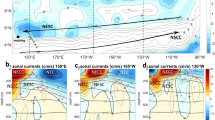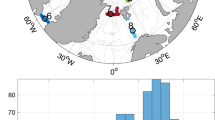Abstract
As part of the global cruise of the Coast and Geodetic Survey ship Oceanographer, a brief investigation of the East Australian Current was conducted in September 1967 by personnel from the Pacific Oceanographic Research Laboratory and the Division of Fisheries and Oceanography. The results reported here are from oceanographic casts along 31° S. extending eastward 170 km from the Australian continental shelf. Closely spaced observations, made feasible by the satellite navigation system on board the ship, revealed some previously unknown details of the current.
This is a preview of subscription content, access via your institution
Access options
Subscribe to this journal
Receive 51 print issues and online access
$199.00 per year
only $3.90 per issue
Buy this article
- Purchase on Springer Link
- Instant access to full article PDF
Prices may be subject to local taxes which are calculated during checkout
Similar content being viewed by others
References
Hamon, B. V., CSIRO Austral. Div. Fish. Oceanogr. Tech. Pap., No. 11 (1961).
Hamon, B. V., Deep-Sea Res., 12, 899 (1965).
Defant, A., Physical Oceanography (Macmillan, New York, 1961).
Swallow, J. C., and Worthington, L. V., Deep-Sea Res., 8, 1 (1961).
Volkmann, G., Deep-Sea Res., 9, 493 (1962).
Barrett, J. R., Deep-Sea Res., 12, 173 (1965).
Author information
Authors and Affiliations
Rights and permissions
About this article
Cite this article
REED, R., RYAN, T., HAMON, B. et al. New Feature of the East Australian Current. Nature 218, 557–558 (1968). https://doi.org/10.1038/218557a0
Received:
Published:
Issue Date:
DOI: https://doi.org/10.1038/218557a0
This article is cited by
-
Geopotential topography of deep levels in the Pacific Ocean
Journal of the Oceanographical Society of Japan (1970)
Comments
By submitting a comment you agree to abide by our Terms and Community Guidelines. If you find something abusive or that does not comply with our terms or guidelines please flag it as inappropriate.



